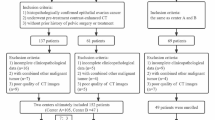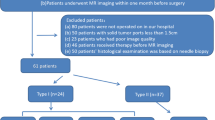Abstract
Objective
To develop and validate a model that can preoperatively identify the ovarian clear cell carcinoma (OCCC) subtype in epithelial ovarian cancer (EOC) using CT imaging radiomics and clinical data.
Material and methods
We retrospectively analyzed data from 282 patients with EOC (training set = 225, testing set = 57) who underwent pre-surgery CT examinations. Patients were categorized into OCCC or other EOC subtypes based on postoperative pathology. Seven clinical characteristics (age, cancer antigen [CA]-125, CA-199, endometriosis, venous thromboembolism, hypercalcemia, stage) were collected. Primary tumors were manually delineated on portal venous-phase images, and 1218 radiomic features were extracted. The F-test-based feature selection method and logistic regression algorithm were used to build the radiomic signature, clinical model, and integrated model. To explore the effects of integrated model-assisted diagnosis, five radiologists independently interpreted images in the testing set and reevaluated cases two weeks later with knowledge of the integrated model’s output. The diagnostic performances of the predictive models, radiologists, and radiologists aided by the integrated model were evaluated.
Results
The integrated model containing the radiomic signature (constructed by four wavelet radiomic features) and three clinical characteristics (CA-125, endometriosis, and hypercalcinemia), showed better diagnostic performance (AUC = 0.863 [0.762–0.964]) than the clinical model (AUC = 0.792 [0.630–0.953], p = 0.295) and the radiomic signature alone (AUC = 0.781 [0.636–0.926], p = 0.185). The diagnostic sensitivities of the radiologists were significantly improved when using the integrated model (p = 0.023–0.041), while the specificities and accuracies were maintained (p = 0.074–1.000).
Conclusion
Our integrated model shows great potential to facilitate the early identification of the OCCC subtype in EOC, which may enhance subtype-specific therapy and clinical management.





Similar content being viewed by others
Abbreviations
- AUC:
-
Area under the curve
- CT:
-
Computed tomography
- CA-125:
-
Cancer antigen-125
- CA-199:
-
Cancer antigen-199
- CI:
-
Confidence interval
- EOC:
-
Epithelial ovarian cancer
- FIGO:
-
International federation of gynecology and obstetrics
- HGSC:
-
High-grade serous carcinoma
- NCCN:
-
National comprehensive cancer network
- OCCC:
-
Ovarian clear cell carcinoma
References
Sung H, Ferlay J, Siegel RL et al (2021) Global cancer statistics 2020: GLOBOCAN estimates of incidence and mortality worldwide for 36 cancers in 185 countries. CA Cancer J Clin 71:209–249. https://doi.org/10.3322/caac.21660
(2020) WHO classification of tumours editorial board. WHO classification of tumours. female genital tumours, (5th edn), IARC Press, Lyon
Iida Y, Okamoto A, Hollis RL, Gourley C, Herrington CS (2021) Clear cell carcinoma of the ovary: a clinical and molecular perspective. Int J Gynecol Cancer 31:605–616. https://doi.org/10.1136/ijgc-2020-001656
Zhu C, Xu Z, Zhang T et al (2021) Updates of pathogenesis, diagnostic and therapeutic perspectives for ovarian clear cell carcinoma. J Cancer 12:2295–2316. https://doi.org/10.7150/jca.53395
Kim SI, Lim MC, Lim J et al (2016) Incidence of epithelial ovarian cancer according to histologic subtypes in Korea, 1999 to 2012. J Gynecol Oncol 27:e5. https://doi.org/10.3802/jgo.2016.27.e5
Oliver KE, Brady WE, Birrer M et al (2017) An evaluation of progression free survival and overall survival of ovarian cancer patients with clear cell carcinoma versus serous carcinoma treated with platinum therapy: an NRG oncology/gynecologic oncology group experience. Gynecol Oncol 147:243–249. https://doi.org/10.1016/j.ygyno.2017.08.004
Lee YY, Kim TJ, Kim MJ et al (2011) Prognosis of ovarian clear cell carcinoma compared to other histological subtypes: a meta-analysis. Gynecol Oncol 122:541–547. https://doi.org/10.1016/j.ygyno.2011.05.009
Takano M, Tsuda H, Sugiyama T (2012) Clear cell carcinoma of the ovary: is there a role of histology-specific treatment? J Exp Clin Cancer Res 31:53. https://doi.org/10.1186/1756-9966-31-53
Chung YS, Park SY, Lee JY et al (2019) Outcomes of non-high grade serous carcinoma after neoadjuvant chemotherapy for advanced-stage ovarian cancer: a Korean gynecologic oncology group study (OV 1708). BMC Cancer 19:341. https://doi.org/10.1186/s12885-019-5514-7
National Comprehensive Cancer Network. NCCN clinical practice guidelines in oncology. ovarian cancer including fallopian tube cancer and primary peritoneal cancer. (Version 1.2023) [cited 2023 Febrary 8] Available from:https://www.nccn.org/professionals/physician_gls/pdf/ovarian.pdf
Colombo N, Sessa C, du Bois A et al (2019) ESMO-ESGO consensus conference recommendations on ovarian cancer: pathology and molecular biology, early and advanced stages, borderline tumours and recurrent disease†. Ann Oncol 30:672–705. https://doi.org/10.1093/annonc/mdz062
Okamoto A, Glasspool RM, Mabuchi S et al (2014) Gynecologic cancer interGroup (GCIG) consensus review for clear cell carcinoma of the ovary. Int J Gynecol Cancer 24:S20-25. https://doi.org/10.1097/igc.0000000000000289
Hoang LN, Zachara S, Soma A et al (2015) Diagnosis of ovarian carcinoma histotype based on limited sampling: a prospective study comparing cytology, frozen section, and core biopsies to full pathologic examination. Int J Gynecol Pathol 34:517–527. https://doi.org/10.1097/pgp.0000000000000199
Stewart CJ, Brennan BA, Hammond IG, Leung YC, McCartney AJ, Ruba S (2008) Intraoperative assessment of clear cell carcinoma of the ovary. Int J Gynecol Pathol 27:475–482. https://doi.org/10.1097/PGP.0b013e31816b5cff
Mayerhoefer ME, Materka A, Langs G et al (2020) Introduction to radiomics. J Nucl Med 61:488–495. https://doi.org/10.2967/jnumed.118.222893
Guiot J, Vaidyanathan A, Deprez L et al (2022) A review in radiomics: making personalized medicine a reality via routine imaging. Med Res Rev 42:426–440. https://doi.org/10.1002/med.21846
Kang SK, Reinhold C, Atri M et al (2018) ACR appropriateness criteria(®) staging and follow-up of ovarian cancer. J Am Coll Radiol 15:S198-s207. https://doi.org/10.1016/j.jacr.2018.03.015
Zhu H, Ai Y, Zhang J et al (2021) Preoperative nomogram for differentiation of histological subtypes in ovarian cancer based on computer tomography radiomics. Front Oncol 11:642892. https://doi.org/10.3389/fonc.2021.642892
Hu Y, Weng Q, Xia H et al (2021) A radiomic nomogram based on arterial phase of CT for differential diagnosis of ovarian cancer. Abdom Radiol 46:2384–2392. https://doi.org/10.1007/s00261-021-03120-w
Wang M, Perucho JAU, Hu Y et al (2022) Computed tomographic radiomics in differentiating histologic subtypes of epithelial ovarian carcinoma. JAMA Netw Open 5:e2245141. https://doi.org/10.1001/jamanetworkopen.2022.45141
An H, Wang Y, Wong EMF et al (2021) CT texture analysis in histological classification of epithelial ovarian carcinoma. Eur Radiol 31:5050–5058. https://doi.org/10.1007/s00330-020-07565-3
Dong S, Yu F, Liu Y et al (2022) Comparison of the clinical characteristics and prognosis between clear cell carcinomas and high-grade serous ovarian carcinomas. Ginekol Pol. https://doi.org/10.5603/GP.a2022.012310.5603/GP.a2022.0123
Park H, Qin L, Guerra P, Bay CP, Shinagare AB (2021) Decoding incidental ovarian lesions: use of texture analysis and machine learning for characterization and detection of malignancy. Abdom Radiol 46:2376–2383. https://doi.org/10.1007/s00261-020-02668-3
Yi X, Liu Y, Zhou B et al (2021) Incorporating SULF1 polymorphisms in a pretreatment CT-based radiomic model for predicting platinum resistance in ovarian cancer treatment. Biomed Pharmacother 133:111013. https://doi.org/10.1016/j.biopha.2020.111013
Boehm KM, Aherne EA, Ellenson L et al (2022) Multimodal data integration using machine learning improves risk stratification of high-grade serous ovarian cancer. Nat Cancer 3:723–733. https://doi.org/10.1038/s43018-022-00388-9
Depeursinge A, Foncubierta-Rodriguez A, Van De Ville D, Müller H (2014) Three-dimensional solid texture analysis in biomedical imaging: review and opportunities. Med Image Anal 18:176–196. https://doi.org/10.1016/j.media.2013.10.005
Xue C, Yuan J, Lo GG et al (2021) Radiomics feature reliability assessed by intraclass correlation coefficient: a systematic review. Quant Imaging Med Surg 11:4431–4460. https://doi.org/10.21037/qims-21-86
Li X, Ye Z (2015) Clear cell carcinoma of the ovary: multi-slice computed tomography findings. World J Surg Oncol 13:133. https://doi.org/10.1186/s12957-015-0546-1
Li M, Tan J, Zhang Y et al (2021) Assessing CT imaging features combined with CEA and CA125 levels to identify endometriosis-associated ovarian cancer. Abdom Radiol 46:2367–2375. https://doi.org/10.1007/s00261-020-02571-x
Liu H, Xu Y, Ji J, Dong R, Qiu H, Dai X (2020) Prognosis of ovarian clear cell cancer compared with other epithelial cancer types: a population-based analysis. Oncol Lett 19:1947–1957. https://doi.org/10.3892/ol.2020.11252
Paik ES, Kim TJ, Choi CH, Kim BG, Bae DS, Lee JW (2018) Clinical outcomes of patients with clear cell and endometrioid ovarian cancer arising from endometriosis. J Gynecol Oncol 29:e18. https://doi.org/10.3802/jgo.2018.29.e18
Marks EI, Brown VS, Dizon DS (2020) Genomic and molecular abnormalities in gynecologic clear cell carcinoma. Am J Clin Oncol 43:139–145. https://doi.org/10.1097/coc.0000000000000641
Pozzati F, Moro F, Pasciuto T et al (2018) Imaging in gynecological disease (14): clinical and ultrasound characteristics of ovarian clear cell carcinoma. Ultrasound Obstet Gynecol 52:792–800. https://doi.org/10.1002/uog.19171
Jian J, Li Y, Pickhardt PJ et al (2021) MR image-based radiomics to differentiate type Ι and type ΙΙ epithelial ovarian cancers. Eur Radiol 31:403–410. https://doi.org/10.1007/s00330-020-07091-2
Qian L, Ren J, Liu A et al (2020) MR imaging of epithelial ovarian cancer: a combined model to predict histologic subtypes. Eur Radiol 30:5815–5825. https://doi.org/10.1007/s00330-020-06993-5
Lambin P, Leijenaar RTH, Deist TM et al (2017) Radiomics: the bridge between medical imaging and personalized medicine. Nat Rev Clin Oncol 14:749–762. https://doi.org/10.1038/nrclinonc.2017.141
Wang R, Cai Y, Lee IK et al (2021) Evaluation of a convolutional neural network for ovarian tumor differentiation based on magnetic resonance imaging. Eur Radiol 31:4960–4971. https://doi.org/10.1007/s00330-020-07266-x
Zhang K, Liu X, Shen J et al (2020) Clinically applicable AI system for accurate diagnosis, quantitative measurements, and prognosis of COVID-19 pneumonia using computed tomography. Cell 181:1423-1433.e1411. https://doi.org/10.1016/j.cell.2020.04.045
Wang X, Sun Z, Xue H et al (2022) A deep learning algorithm to improve readers’ interpretation and speed of pancreatic cystic lesions on dual-phase enhanced CT. Abdom Radiol 47:2135–2147. https://doi.org/10.1007/s00261-022-03479-4
Tanaka YO, Okada S, Satoh T et al (2016) Differentiation of epithelial ovarian cancer subtypes by use of imaging and clinical data: a detailed analysis. Cancer Imaging 16:3. https://doi.org/10.1186/s40644-016-0061-9
Collins GS, Reitsma JB, Altman DG, Moons KG (2015) Transparent reporting of a multivariable prediction model for individual prognosis or diagnosis (TRIPOD): the TRIPOD statement. BMJ 350:g7594. https://doi.org/10.1136/bmj.g7594
Acknowledgements
This work was supported by grants from Natural Science Foundation of China (grant No. 81901829), National High Level Hospital Clinical Research Funding (grant No. 2022-PUMCH-A-004) and Natural Science Foundation of China (grant No. 82271886)
Funding
This work was supported by grants from Natural Science Foundation of China (grant No. 81901829), National High Level Hospital Clinical Research Funding (grant No. 2022-PUMCH-A-004) and Natural Science Foundation of China (grant No. 82271886).
Author information
Authors and Affiliations
Contributions
All authors contributed to the study conception and design. YLH, ZYJ, and HDX contributed to the conception and design of the study. XYL, JZ and CW contributed to the acquisition of clinical data. JR, LM and XLL contributed to data analysis and interpretation. JR and LM contributed to statistical analyses. JR, YL, and YLH participated in manuscript preparation, edition and revision. All authors have read and approved the final manuscript.
Corresponding authors
Ethics declarations
Conflict of interest
Co-authors Li Mao and Xiu-Li Li are employees of AI Lab, Deepwise Healthcare, China. The other authors have no conflicts of interest to disclose. The authors not employed by AI Lab, Deepwise Healthcare were in control of this study.
Ethical approval
This retrospective study was approved by the Institutional Review Board of the Peking Union Medical College Hospital (I-22PJ945), and the consents from patients were waived.
Additional information
Publisher's Note
Springer Nature remains neutral with regard to jurisdictional claims in published maps and institutional affiliations.
Rights and permissions
Springer Nature or its licensor (e.g. a society or other partner) holds exclusive rights to this article under a publishing agreement with the author(s) or other rightsholder(s); author self-archiving of the accepted manuscript version of this article is solely governed by the terms of such publishing agreement and applicable law.
About this article
Cite this article
Ren, J., Mao, L., Zhao, J. et al. Seeing beyond the tumor: computed tomography image-based radiomic analysis helps identify ovarian clear cell carcinoma subtype in epithelial ovarian cancer. Radiol med 128, 900–911 (2023). https://doi.org/10.1007/s11547-023-01666-x
Received:
Accepted:
Published:
Issue Date:
DOI: https://doi.org/10.1007/s11547-023-01666-x




